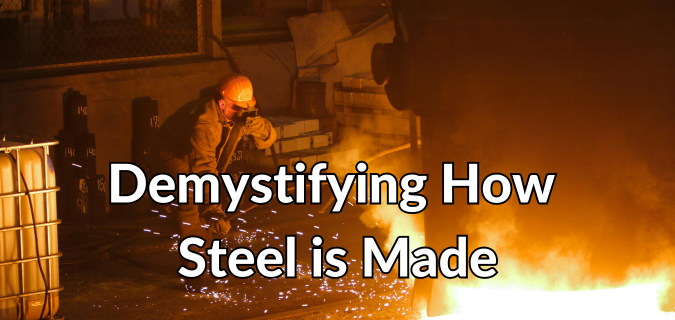
In the simplest of terms, steel is a combination of iron and carbon, but how iron and carbon (and other alloying elements) come together to create steel with different properties and characteristics is a far more complex matter. Steel is the most significant and extensively used construction material on the planet, as evidenced by its use across all manufacturing industries, and over 3,500 grades of steel have unique properties expressly designed to suit specific applications. Plus, steel is 100% recyclable.
Iron vs Steel
The difference between iron and steel is that steel is essentially iron that has been modified for a specific purpose. Iron is an element (number 26, symbol Fe). Steel is iron that has been combined with carbon (usually 2% carbon or less) that strengthens the material, plus other alloying elements that can, for example, increase or decrease ductility, hardness, or corrosion resistance. Put another way: all steel contains iron; not all iron is steel.
There are two predominant methods for producing steel: the blast furnace (BF), which primarily creates new steel, and the electric arc furnace (EAF), which typically produces steel from recycled materials.
Steel Production with the Blast Furnace
The chemical process in a blast furnace is called reduction. The first step in the steel production process using a blast furnace is to convert iron ore into iron. Iron ore is an oxide, meaning oxygen needs to be removed in order to simplify the material into iron. To do this, manufacturers use coal (which, when cooked, becomes coke) as fuel and limestone as a fluxing agent. More and more frequently, natural gas is being used in coal’s place in an effort to reduce CO2 emissions, but we’ll continue to refer to coal here to be true to the process that was first invented in the 14th century.
The coal (coke), iron ore, and limestone (which helps get rid of impurities during the refining process) come out of the blast furnace as molten iron (if allowed to cool in this state, the iron would be brittle and hard to form). Thus, the next step is a converter, which is essentially an oxygen furnace. The converter blows oxygen into the liquid iron, which reacts with unwanted elements and impurities, such as manganese, silicon, or certain levels of carbon, leaving us with the finished product: steel. This steel can then be formed and processed into bars, wire, and other products.
Steel Production with the Electric Arc Furnace
The electric arc furnace (EAF) is becoming more prevalent in the industry and is particularly adept at utilizing recycled steel scrap, although it can also handle iron that has been combined with coal or natural gas via direct reduction. An EAF uses electrical current to melt steel scrap, with the heat coming from the electric arc’s electrodes interacting with the charge of the metal.
An EAF can use many different types of steel scrap, remove impurities, and easily incorporate alloys into the finished product. Once the steel is created, it can be processed and formed in the same way steel from a blast furnace is processed.
With the increasing use of natural gas instead of coal, the 100% recyclability of steel, and the many additional efforts manufacturers are making to reduce their environmental impact, the steel industry continues to inspire other industries in the ways of green manufacturing. In 2024, we installed a Solar Array system at one of our facilities.
Watch Capital Steel president and owner, Kelly Preston, and director of manufacturing, Fred Render, discuss the Solar Array in this video. By the way, since we mentioned Kelly, did you know Capital Steel was named a 2025 Women-Owned Small Business of the Year?
The Power of Steel Alloys
Here’s the secret to why steel is so incredibly versatile: alloys. An alloy’s impact on steel is seemingly limitless.
An alloy steel is any steel that has had elements other than carbon added to the steel (steel that is completely composed of iron and carbon is called carbon steel). Low-alloy steels contain fewer than 8% by weight of alloying elements, and high-alloy steels contain 8% or more alloying elements.
Because different alloys produce different attributes, manufacturers can create very specific steels that are perfectly suited for their applications. For instance, adding nickel adds strength and improves temperature resistance. Chromium improves resistance to corrosion. Some other popular alloying elements: manganese, copper, nitrogen, silicon, titanium, aluminum, molybdenum, and cobalt. Many combinations of elements also work together to create the desired properties—hardness, durability, ductility, strength, temperature resistance, corrosion resistance, weldability, formability, and others—of the finished steel product.
Types of Steel and their Uses
Harnessing the power of steel alloys brings us several steel categories, including:
Carbon steels are frequently used in machinery and in the construction and automotive industries. Carbon steels are economical and can be fabricated to possess multiple valuable characteristics, such as weldability, strength, hardness or and wear-resistance.
Stainless steel is a strong material that resists corrosion due to its chromium content of 11% or greater. Stainless steel also resists extreme temperatures and is thus common in many industries, including machinery, utensils, and food handling, as well as exterior construction components. Many household appliances and surgical instruments are likewise often made of stainless steel.
Tool steels are appropriately named. Their primary application: tools. Tool steels are wear-resistant, heat-resistant, and tough.
Within each category, there are many grades of steel that further refine their specific uses. Learn more about finding the most optimal steel grade for your needs.
Partner with Capital Steel for Green Steel Solutions
As steel manufacturing continues to get more and more environmentally friendly, let Capital Steel help you sort through how you can get the right steel for your project. Contact us today to start the conversation.





